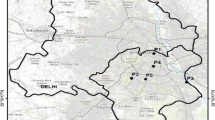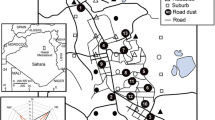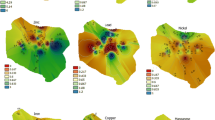Abstract
To identify the best material (soil or dust) to be selected for health-risk assessment studies, road dust and urban soil from three cities with different population densities were collected, and size fractions were analysed for metal content (Pb, Zn, Cu, Cd, Cr, Co, and Ni). Results showed similar distribution of the size particles among cities, predominating fractions between 75 and 2000 μm in road dust and particles below 75 μm in soil. Metals were mainly bound to PM10 in both soil and road dust increasing the risk of adverse health effects, overall through inhalation exposure. The risk assessment showed that the most hazardous exposure pathway was the ingestion via, followed by dermal absorption and inhalation route. Values of hazard quotient showed that the risk for children due to the ingestion and dermal absorption was higher than adults, and slightly larger at PM10 comparing to <75-μm fraction for the inhalation route. Higher risk values were found for road dust, although any hazard index or cancer risk index value did not overreach the safe value of 10−6.




Similar content being viewed by others
References
Acosta JA, Faz A, Arocena JM, Debela F, Martínez-Martínez S (2009) Distribution of metals in soil particle size fractions and its implication to risk assessment of playgrounds in Murcia City (Spain). Geoderma 149:101–109
Acosta JA, Faz A, Kalbitz K, Jansen B, Martinez-Martinez S (2011) Heavy metal concentrations in particle size fractions from street dust of Murcia (Spain) as the basis for risk assessment. J Environ Monit 13:3087–3092
Acosta JA, Gabarrón M, Faz A, Martínez-Martínez S, Zornoza R, Arocena JM (2015) Influence of population density on the concentration and speciation of metals in the soil and street dust from urban areas. Chemosphere 134:328–337
Amato F, Pandolfi M, Viana M, Querol X, Alastuey A, Moreno T (2009) Spatial and chemical patterns of PM10 in road dust deposited in urban environment. Atmos Environ 43:1650–1659
Boisa N, Entwistle J, Dean JR (2014) A new simple, low-cost approach for generation of the PM10 fraction from soil and related materials: application to human health risk assessment. Anal Chim Acta 852:97–104
Cao Z, Yang Y, Lu J, Zhang C (2011) Atmospheric particle characterization, distribution, and deposition in Xi’an, Shaanxi Province, Central China. Environ Pollut 159:577–584
Chen H, Teng Y, Lu S, Wang Y, Wu J, Wang J (2016) Source apportionment and health risk assessment of trace metals in surface soils of Beijing metropolitan, China. Chemosphere 144:1002–1011
De Miguel E, Jimenez de Grado J, Llamas JF, Martin-Dorado A, Mazadiego LF (1998) The overlooked contribution of compost application of the trace element load in the urban soil of Madrid (Spain). Sci Total Environ 215:113–122
De Miguel E, Iribarren I, Chacón E, Ordoñez A, Charlesworth S (2007) Risk-based evaluation of the exposure of children to trace elements in playgrounds in Madrid (Spain). Chemosphere 66:505–513
Dehghani S, Moore F, Keshavarzi B, Hale BA (2017) Health risk implications of potentially toxic metals in street dust and surface soil of Tehran, Iran. Ecotoxicol Environ Saf 136:92–103
Du Y, Gao B, Zhou H, Ju X, Hao H, Yin S (2013) Health risk assessment of heavy metals in road dusts in urban parks of Beijing, China. Proc Environ Sci 18:299–309
Duong TT, Lee BK (2011) Determining contamination level of heavy metals in road dust from busy traffic areas with different characteristics. J Environ Manag 92:554–562
Ferreira-Baptista L, De Miguel E (2005) Geochemistry and risk assessment of Street dust in Luanda, Angola: a tropical urban environment. Atmos Environ 39:4501–4512
García-Rico L, Meza-Figueroa D, Gandolfi A, Del Rio-salas R, Romero F, Meza-Montenegro MM (2016) Dust-metal sources in an urbanized arid zone: implications for health-Risk assessment. Arch Environ Contam Toxicol 70:522–533
Gope M, Masto RE, George J, Hoque RR, Balachandran S (2017) Bioavailability and health risk of some potentially toxic elements (Cd, Cu, Pb and Zn) in street dust of Asansol, India. Ecotoxicol Environ Saf 138:231–241
Han Y, Cao J, Posmentier E, Fung K, Tian H, An Z (2008) Particulate-associated potentially harmful elements in urban road dusts in Xi’an, China. Appl Geochem 23:835–845
Hou Q, An X, Tao Y, Sun Z (2016) Assessment of resident’s exposure level and health economic costs of PM10 in Beijing from 2008 to 2012. Sci Total Environ 563–564:557–565
Huang J, Liu W, Zeng W, Li F, Huang X, Gu Y, Shi L, Shi Y, Wan J (2016) An exploration of spatial human health risk assessment of soil toxic metals under different land uses using sequential indicator simulation. Ecotoxicol Environ Saf 129:199–209
Izquierdo M, De Miguel E, Ortega MF, Mingot J (2015) Bioaccessibility of metals and human health risk assessment in community urban gardens. Chemosphere 135:312–318
Kong S, Lu B, Ji Y, Zhao X, Chen L, Li Z, Han B, Bai Z (2011) Levels, risk assessment and sources of PM10 fraction heavy metals in four types dust from a coal-based city. Microchem J 98:280–290
Li H, Qian X, Hu W, Wang Y, Gao H (2013) Chemical speciation and human health risk of trace metals in urban street dusts from a metropolitan city, Nanjing, SE China. Sci Total Environ 456–457:212–221
Li H-H, Chen L-J, Yu L, Guo Z-B, Shan C-Q, Lin J-Q, Gu Y-G, Yang Z-B, Yang Y-X, Shao J-R, Zhu X-M, Cheng Z (2017a) Pollution characteristics and risk assessment of human exposure to oral bioaccessibility of heavy metals via urban street dusts from different functional areas in Chengdu, China. Sci Total Environ 586:1076–1084
Li HX, Ji HB, Shi CJ, Gao Y, Zhang Y, Xu XY, Ding HJ, Tang L, Xing YX (2017b) Distribution of heavy metals and metalloids in bulk and particle size fractions of soils from coal-mine brownfield and implications on human health. Chemosphere 172:505–515
Lim H, Lee J, Chon H, Sager M (2008) Heavy metal contamination and health risk assessment in the vicinity of the abandoned Songche on Au–Ag mine in Korea. J Geochem Explor 96:223–230
Liu E, Yan T, Birch G, Zh Y (2014) Pollution and health risk of potentially toxic metals in urban road dust in Nanjing, a mega-city of China. Sci Total Environ 476–477:522–531
Ljung K, Torin A, Smirk M, Maley F, Cook A, Weinstein P (2008) Extracting dust from soil: a simple solution to a tricky task. Sci Total Environ 407:589–593
Lu X, Wu X, Wang Y, Chen H, Gao P, Fu Y (2014) Risk assessment of toxic metals in street dust from a medium-sized industrial city of China. Ecotox Environ Saf 106:154–163
Luo XS, Xue Y, Wang YL, Cang L, Xu B, Ding J (2015) Source identification and apportionment of heavy metals in urban soil profiles. Chemosphere 127:152–157
Porta J, López-Acevedo M, Roquero C (1999) Edafología para la agricultura y el medio ambiente, 2 Edición. Ediciones Mundi-Prensa, Madrid, España
Qin JH, Nworie OE, Lin CX (2016) Particle size effects on bioaccessible amounts of ingestible soil-borne toxic elements. Chemosphere 159:442–448
RAIS-The Risk Assessment Information System (2016) https://rais.ornl.gov/tools/tox_profiles.html. Accessed April 2016
Risser JA, Baker DE (1990) Testing soils for toxic metals. In: Westerman RL (ed) Soil testing and plant analysis. Special Publication, 3.3rd edn. Soil Science Society of America, Madison, pp 275–298
Shi G, Chen Z, Xu S, Zhang J, Wang L, Bi C, Teng J (2008) Potentially toxic metal contamination of urban soils and roadside dust in Shanghai, China. Environ Pollut 156:251–260
Sun Y, Zhou Q, Xie X, Liu R (2010) Spatial, sources and risk assessment of heavy metal contamination of urban soils in typical regions of Shenyang, China. J Hazard Mater 174:455–462
Tang Y, Han G (2017) Characteristics of major elements and heavy metals in atmospheric dust in Beijing, China. J Geochem Explor 176:114–119
Teng Y, Li J, Wu J, Lu S, Wang Y, Chen H (2015) Environmental distribution and associated human health risk due to trace elements and organic compounds in soil in Jiangxi province, China. Ecotoxicol Environ Saf 122:406–416
US-EPA (1986) Superfund public health evaluation manual. Office of Emergency and Remedial Response. U.S. Environmental Protection Agency Washington, 20460. EPA/540/1-86/060
US-EPA (1989) Risk assessment guidance for superfund volume I human health evaluation manual (Part A). Office of Emergency and Remedial Response. U.S. Environmental Protection Agency Washington, 20450. EPA/540/1-89/002
US-EPA (1992a) Guidelines for exposure assessment. Risk Assessment Forum. U.S. Environmental Protection Agency Washington, EPA/600/Z-92/001
US-EPA (1992b) Supplemental guidance to RAGS: Calculating the Concentration Term. Office of Solid Waste and Emergency Response Washington, 20460. PB92-963373
US-EPA (1996) Soil screening guidance: Technical Background Document. Office of Solid Waste and Emergency Response. Washington, 20460. EPA/540/R95/128
US-EPA (2002a) Supplemental guidance for developing soil screening levels for superfund sites. Office of Solid Waste and Emergency Response. OSWER 9355.4-24
US-EPA (2002b) Calculating upper confidence limits for exposure point concentrations at hazardous waste sites. Office of Emergency and Remedial Response U.S. Environmental Protection Agency Washington, 20460. OSWER 9285.6-10
US-EPA (2004) Risk assessment guidance for superfund volume I: human health evaluation manual (Part E, Supplemental Guidance for Dermal Risk Assessment). Office of Superfund Remediation and Technology Innovation U.S. Environmental Protection Agency Washington, EPA/540/R/99/005
US-EPA (2009) Integrated science assessment for particulate matter. National Center for Environmental Assessment-RTP Division. Office of Research and Development. U.S. Environmental Protection Agency. Research Triangle Park, EPA/600/R-08/139F
US-EPA (2011a) Exposure factors handbook: 2011 edition. National Center for Environmental Assessment Office of Research and Development U.S. Environmental Protection Agency Washington, 20460. EPA/600/R-09/052F
US-EPA (2011b) Highlights of the exposure factors handbook. National Center for Environmental Assessment.Office of Research and Development, Washington, 20460. EPA/600/R-10/030
US-EPA (2016a) in: https://www.epa.gov/risk/human-health-risk-assessment. Accessed April 2016
US-EPA (2016b) https://www3.epa.gov/pm/health.html. Accessed April 2016
Van der Berg R (1995) Human exposure to soil contamination: a qualitative and quantitative analysis towards proposal for human toxicological intervention values. Report no. 725201011. National institute of Public Health and Environmental protection. Bilthoven
Wang J, Li S, Cui X, Li H, Qian X, Wang C, Sun Y (2016) Bioaccessibility, sources and health risk assessment of trace metals in urban park dust in Nanjing, Southeast China. Ecotoxicol Environ Saf 128:161–170
Wong CSC, Li X, Thornton I (2006) Urban environmental geochemistry of trace metals. Environ Pollut 142:1–16
Zhang C, Qiao Q, Appel E, Huang B (2012) Discriminating sources of anthropogenic heavy metals in urban street dusts using magnetic and chemical methods. J Geochem Explor 119–120:60–75
Acknowledgements
Financial support to conduct this study was provided by the Fundación Séneca of Comunidad Autónoma de Murcia (Spain).
Author information
Authors and Affiliations
Corresponding author
Rights and permissions
About this article
Cite this article
Gabarrón, M., Faz, A. & Acosta, J.A. Soil or Dust for Health Risk Assessment Studies in Urban Environment. Arch Environ Contam Toxicol 73, 442–455 (2017). https://doi.org/10.1007/s00244-017-0413-x
Received:
Accepted:
Published:
Issue Date:
DOI: https://doi.org/10.1007/s00244-017-0413-x




